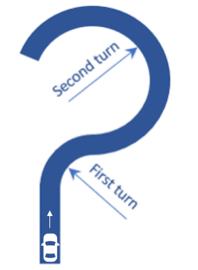J-turn
The J-turn event (or Fishhook maneuver) simulates the vehicle response to a large steer in one direction, a dwell time to allow the vehicle to react, and a large steer in the opposite direction, with an additional reaction time.
The event is used to characterize the stability of vehicles. Both steer directions can be run by reversing the sign of the steering inputs. The Altair Driver is used to maintain a constant speed and standard outputs for the vehicle and tires are included in the Tire system and the Output Requests system.
The J-Turn event follows the ISO +7401-2003 - Road Vehicles-Lateral transient response test methods-Open-loop test methods. It is also designed to simulate the NHTSA fishhook test as described in DOT publication DOT HS 809 705, “Phase VIII of NHTSA’s Light Vehicle Rollover Research Program-A Demonstration of the Dynamic Tests Developed for NHTSA’s NCAP Rollover Rating System”.

Figure 1. J-turn event
Parameters
| Parameter Name | Description |
|---|---|
| Units | Describes the Length, Velocity, and Acceleration units.
|
| Velocity | Initial vehicle velocity. |
| Initial power run | The time at the beginning of the event used to verify the vehicle reached the steady state. |
| First turn direction | Defines the steer direction used in the first turn. |
| First steer angle* | Angle in degrees of the initial steer input. A positive number turns the vehicle right and a negative number turns the vehicle left. |
| First lean angle** | The demand lean angle for the initial turn in degrees. |
| First step duration | Time required to input the First steer angle (a step function is used to input the angle to the steering wheel). |
| First turn duration | Time duration for which the steering is held fixed at the First steer angle. |
| Second turn direction | Defines the direction used in the second turn. |
| Second steer angle* | Steering angle in degrees of the second steer input. |
| Second lean angle** | The demand lean angle for the second turn in degrees. |
| Second step duration | The time required to input the Second steer angle (a step function is used to input the angle to the steering wheel). |
| Second turn duration | Time duration for which steering is held fixed at the Second steer angle. |
*Applicable only for Cars/Trucks i.e., Non-leaning events.
**Applicable only for Two-wheeler i.e., Leaning events.
Controller Settings
- Non-leaning events (Cars/Trucks)
- LONGITUDINAL – TRACTION CONTROLLER SETTINGS
- Use additional control: Enables the additional feedback control for the traction
control. The gains for the controller can be edited by toggling this check
box.
Kp Proportional gain for the feedback PID controller Ki Integral gain for the feedback PID controller Kd Derivative gain for the feedback PID controller
- Use additional control: Enables the additional feedback control for the traction
control. The gains for the controller can be edited by toggling this check
box.
- Leaning events (Two-wheelers)
- LONGITUDINAL – TRACTION CONTROLLER SETTINGS
- Use additional control: Enables the additional feedback control for the traction
control. The gains for the controller can be edited by toggling this check
box.
Kp Proportional gain for the feedback PID controller Ki Integral gain for the feedback PID controller Kd Derivative gain for the feedback PID controller
- Use additional control: Enables the additional feedback control for the traction
control. The gains for the controller can be edited by toggling this check
box.
Signal Settings
Use the signal settings to set minimum, maximum, smooth frequency and initial values for Steering, Throttle, Brake, Gear, and Clutch signals output by the driver.
The smoothing frequency is used to control how fast the Driver changes signals. Only closed loop control signals from the Driver are smoothed. Open loop signals are not smoothed.
Road Settings
- Flat Road
- Uses a flat smooth road for the event with no required road file.When the Flat Road is selected, the Graphics Setting option is available with the following parameters:
- View path centerline: Enables the visualization of the event path.
- This check box is disabled for open loop events without a path.
- View grid graphics: Enables the visualization of the road grid graphics.
- When view grid graphics check box is toggled, road grid parameters can be edited in the Grid Settings tab.
Grid length Defines the length of the road. Enter a positive value in the model units. Grid Width Defines the width of the road. Enter a positive value in the model units. Grid X offset Gives a distance offset to the road graphics in the longitudinal direction. Enter a positive value in the model units. Grid Y offset Gives a distance offset to the road graphics in the lateral direction. Enter a positive value in the model units.
- View path centerline: Enables the visualization of the event path.
- Road File
- The road file option enables the selection of a road file to be used in the event. Using this option, all tires in the model consider the event specified road file instead of the file included in the tire entities.
- Tires
- Using Tire as road selection option, the road file specified in the tire entity is used in the events simulation.
Automated Output Report
| Report Name | Report Signals |
|---|---|
| Tire Lateral Slip |
|
| Vertical Tire Forces |
|
| Vertical Tire Forces vs. Lateral Acceleration |
|
| Axle Loads |
|
| Steering, Torque and Roll |
|
| Sideslip |
|
| CG Sideslip Angle |
|
| Lateral Load Transfer |
|
| Steering Wheel Angle vs. Time | |
| Vehicle CG Displacement vs. Time |